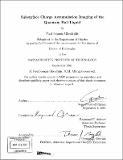| dc.contributor.advisor | Raymond C. Ashoori. | en_US |
| dc.contributor.author | Glicofridis, Paul Ioannis, 1973- | en_US |
| dc.contributor.other | Massachusetts Institute of Technology. Dept. of Physics. | en_US |
| dc.date.accessioned | 2006-03-24T18:00:49Z | |
| dc.date.available | 2006-03-24T18:00:49Z | |
| dc.date.copyright | 2001 | en_US |
| dc.date.issued | 2001 | en_US |
| dc.identifier.uri | http://hdl.handle.net/1721.1/29894 | |
| dc.description | Thesis (Ph. D.)--Massachusetts Institute of Technology, Dept. of Physics, 2001. | en_US |
| dc.description | Includes bibliographical references (p. 161-172). | en_US |
| dc.description.abstract | We describe results obtained by a novel scanning technique, called Subsurface Charge Accumulation (SCA) Imaging, that enables the direct imaging of electronic systems buried inside semiconductor materials. Using SCA Imaging, we image and measure properties of a two-dimensional electron system (2DES) in a GaAs/AlGaAs heterostructure, in the regime of the integer quantum Hall effect. We observe general charging features in a plain 2DES near quantum Hall integer filling factors. We proceed by imaging low compressibility strips in the presence of an artificially created density gradient in the 2DES. We study them in detail at Landau level filling factors v = 2, 4. The strips appear significantly wider than predicted by theory and we account for the discrepancy by presenting a model that considers the disorder-induced nonzero density of states in the cyclotron gap. We also measure the charging properties of incompressible strips that form parallel to the edges of a metal gate deposited on the surface of our sample. An RC model considering charging of the 2DES across the strip, closely fits the data. This allows us to determine the longitudinal resistivity of the incompressible part of the edge state that runs parallel to the gate, for a range of filling factors. Surprisingly, the strip becomes more resistive in regions of high electronic density gradient, where its width is expected to decrease. By sensing charge from the motion of single electrons inside the 2DES we produce a topographic map of the random potential inside the integer quantum Hall liquid. | en_US |
| dc.description.abstract | (cont.) We achieve this by creating a mobile quantum dot inside the 2DES. By scanning the dot, single electrons enter or leave it, in response to the local potential. Detection of this motion leads to the creation of a potential contour map. We find that the 2D electron screening of the random potential induced by external impurities, changes little between quantum Hall plateaus and within each plateau. We finally present preliminary results from a 2DES sample with a built-in backgate. The backgate enables us to deplete the 2DES and perform measurements in the regime of low electronic densities. | en_US |
| dc.description.statementofresponsibility | by Paul Ioannis Glicofridis. | en_US |
| dc.format.extent | 172 p. | en_US |
| dc.format.extent | 14844313 bytes | |
| dc.format.extent | 14844118 bytes | |
| dc.format.mimetype | application/pdf | |
| dc.format.mimetype | application/pdf | |
| dc.language.iso | eng | en_US |
| dc.publisher | Massachusetts Institute of Technology | en_US |
| dc.rights | M.I.T. theses are protected by copyright. They may be viewed from this source for any purpose, but reproduction or distribution in any format is prohibited without written permission. See provided URL for inquiries about permission. | en_US |
| dc.rights.uri | http://dspace.mit.edu/handle/1721.1/7582 | |
| dc.subject | Physics. | en_US |
| dc.title | Subsurface Charge Accumulation imaging of the quantum Hall liquid | en_US |
| dc.title.alternative | SCA imaging of the quantum Hall liquid | en_US |
| dc.type | Thesis | en_US |
| dc.description.degree | Ph.D. | en_US |
| dc.contributor.department | Massachusetts Institute of Technology. Department of Physics | |
| dc.identifier.oclc | 50420149 | en_US |
